Crucifixions in retro sci-fi art
Plus 'Dr. No' and, uh, dinosaur sex. A real mixed bag here.

I usually try to post some holiday-themed sci-fi art on my blog, but I’m just as likely to forget. I thought I had a good run this Easter with this post, which paired up a giant pink space bunny with a lot of Easter Island-related UFO art. But today I realized that I missed a chance to talk about crucifixions and cross-related imagery, a more rich vein of sci-fi art.
I’m not patient enough to wait until next Easter, so I figured I’d sample them here, with a little commentary.
First, here’s my personal favorite, Frank Frazetta’s alien cross. It’s a great concept, even if Frazetta’s clearly more of an expert at actual human anatomy than he is at imagining how an alien’s might work. Which is fine, we’ve got Wayne Barlowe for that.
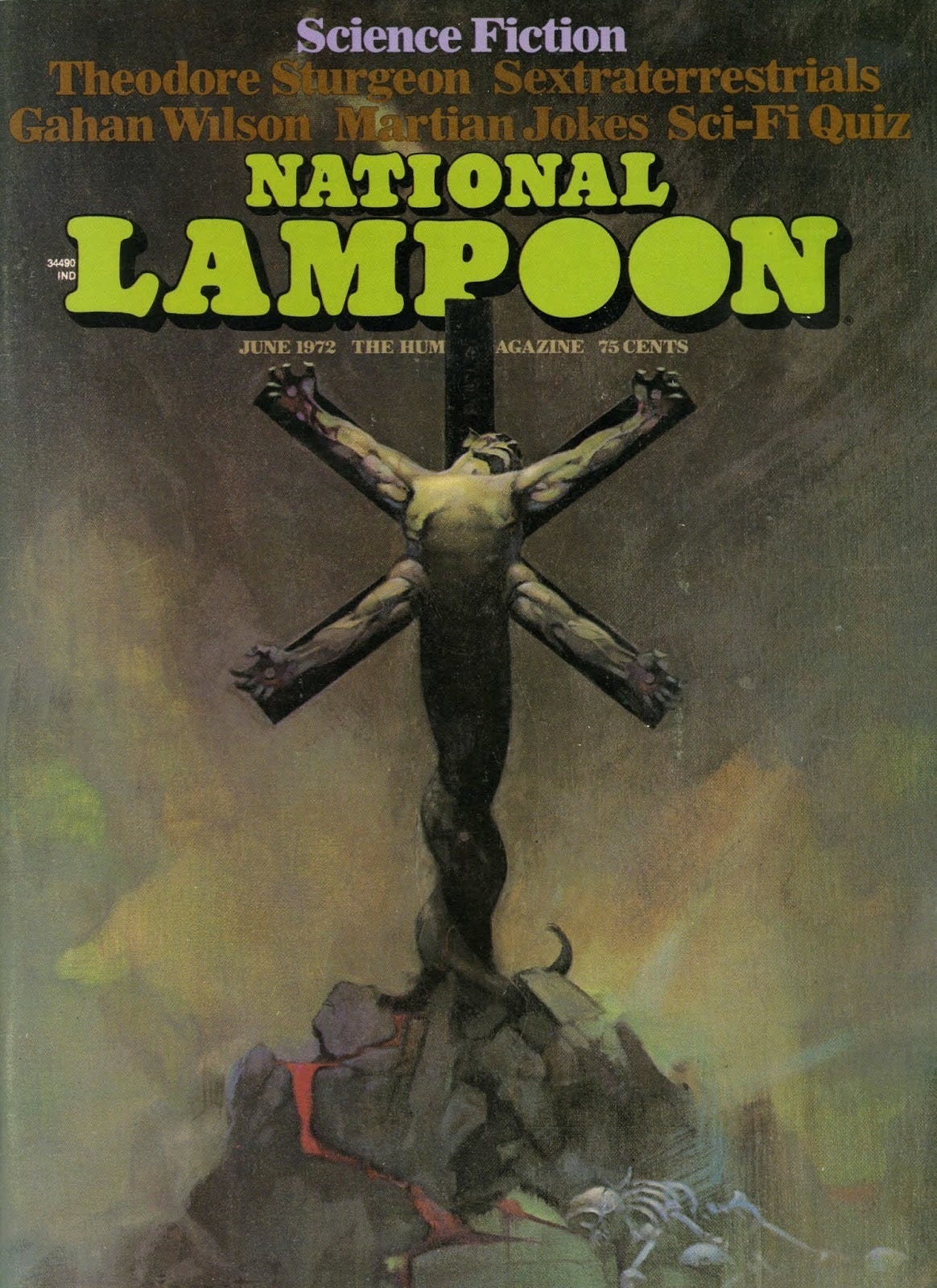
Then there’s this 1954 Amazing Stories cover by Ed Valigursky, under the "William Rembach" pseudonym. Perhaps not quite a crucifixion scene, since it could be more of a scarecrow deal. It does appear to be an illustration for the very unsubtly titled story “Blessed Are the Murderous.”
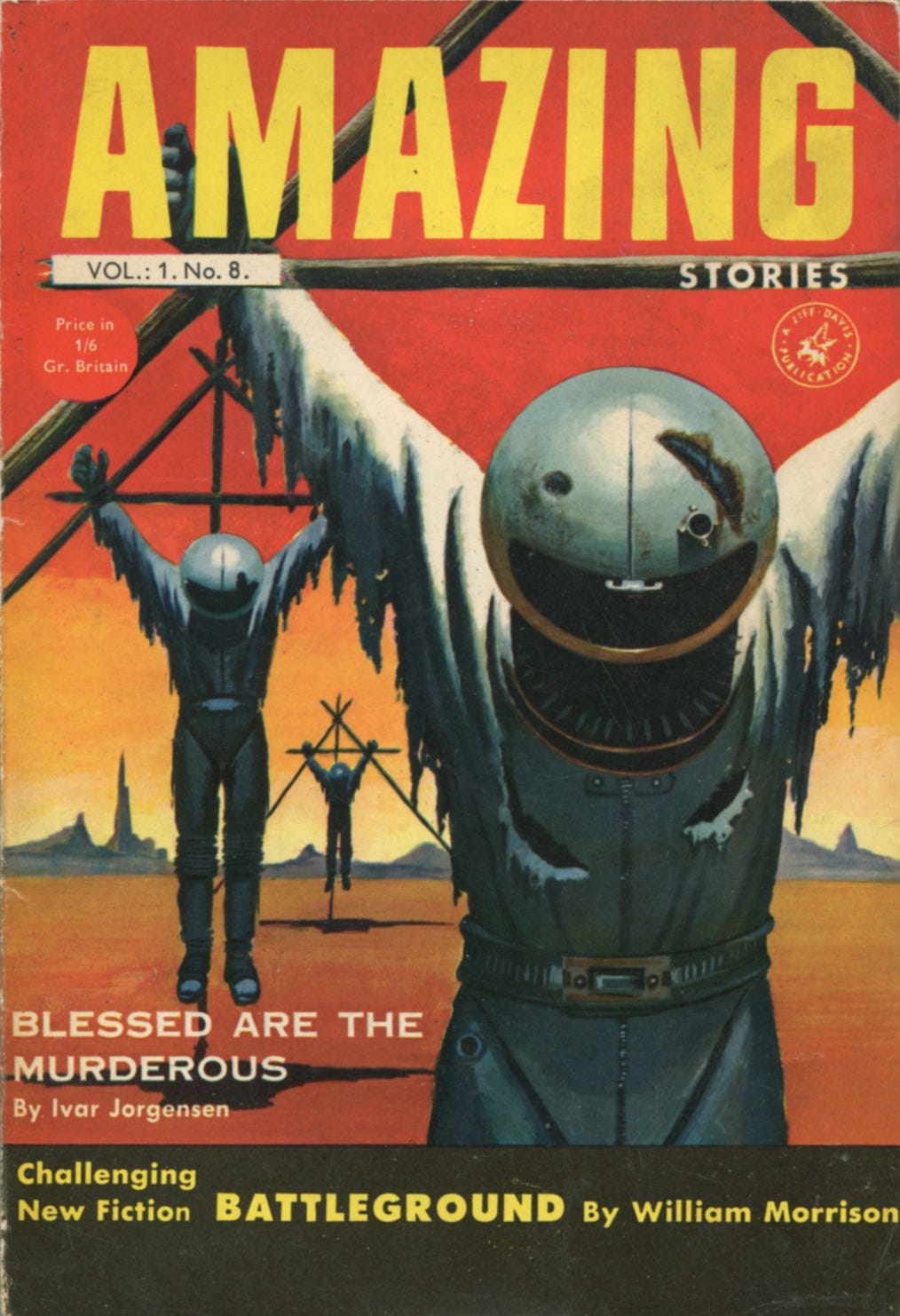
Jim Burns did this next one to illustrate Harry Harrison's The Streets Of Ashkelon, a short story in which a missionary teaches an aquatic alien race about Christianity, only for them to crucify him in hope that he’ll be resurrected. It’s also not really a nuanced take, which seems to be a pattern for this era’s religion-centric sci-fi.

Plus there’s the Philip José Farmer book Jesus on Mars. Here’s Paul Stinson’s 1979 cover and Melvyn Grant’s 1982 cover.
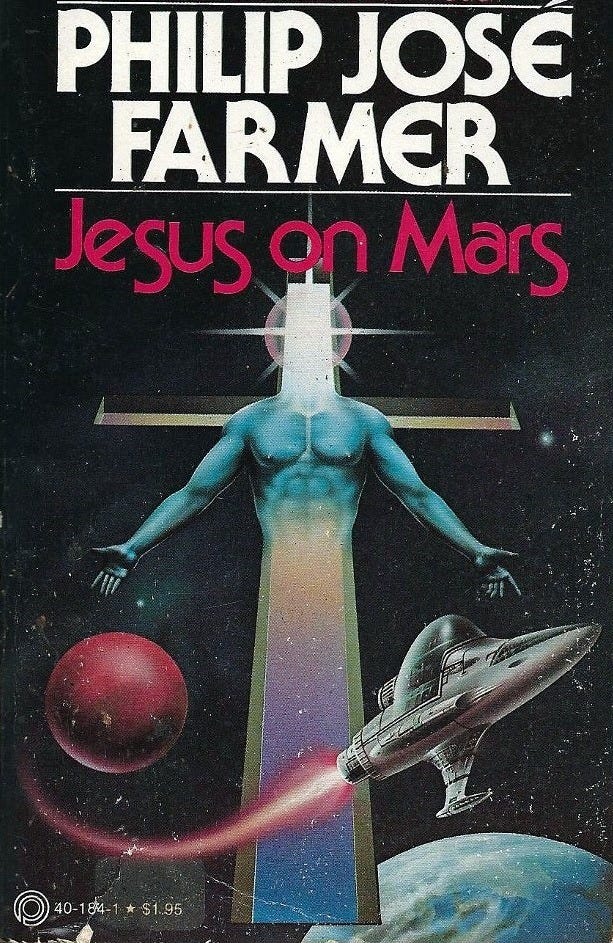
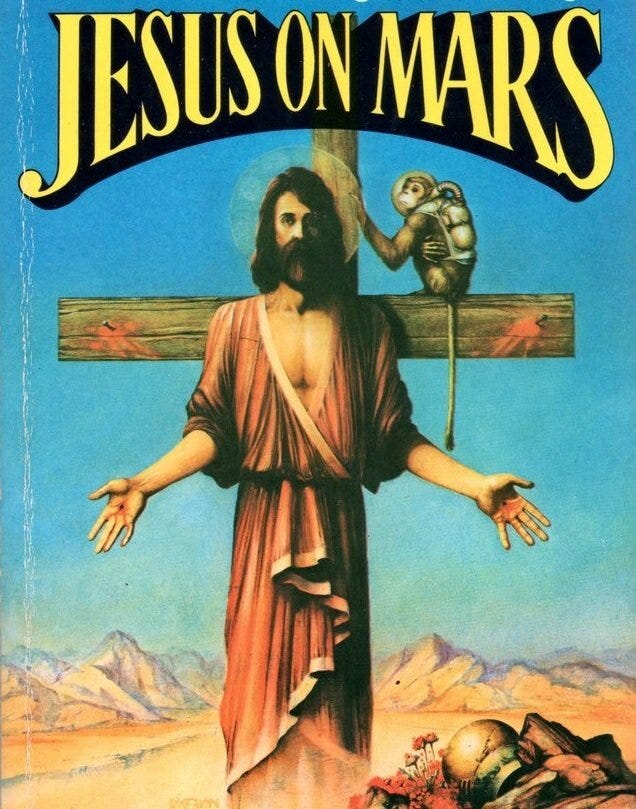
Michael Whelan created perhaps the most retro possible version, with a crucifixion carried out on a giant computer punch card for a 1978 cover to Mack Reynolds’ Day After Tomorrow.
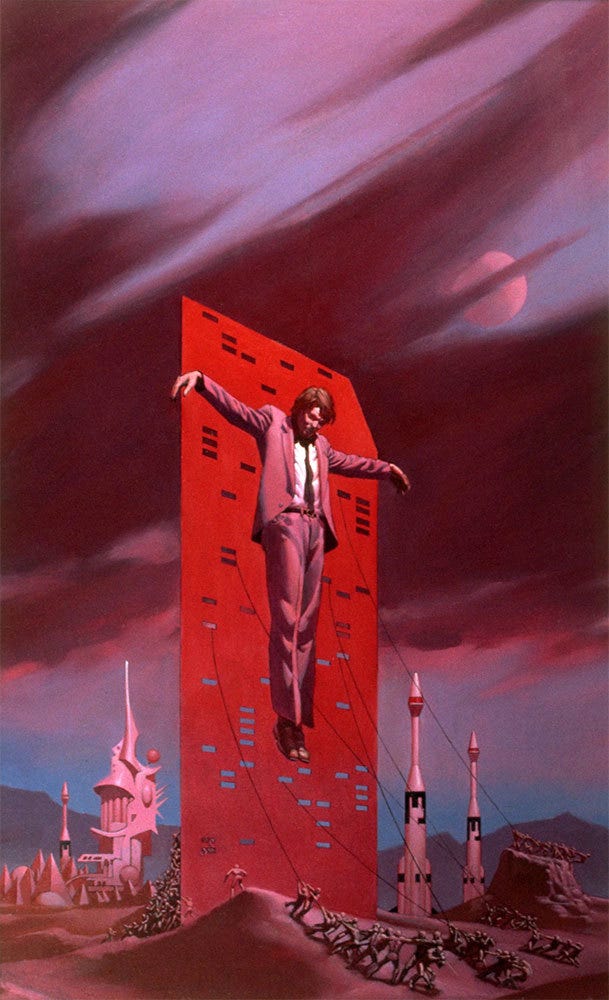
And of course there’s Walter M. Miller, Jr.’s A Canticle for Leibowitz, which has too many great covers to show here, so I’ll just end with Peter Andrew Jones’ 1979 wraparound:
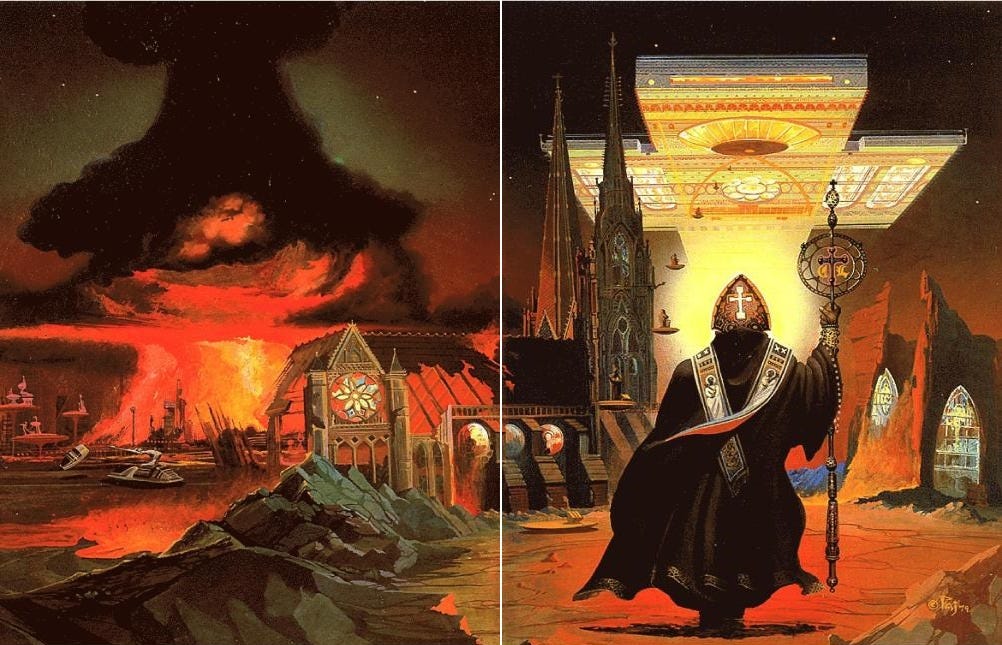
There’s a few more in my “cross” tag on tumblr, although you’ll have to comb through all the red cross hospital spaceships, which are themselves worth a themed roundup like this one!
***
Just participated in an interesting Twitter thread over here (scroll to the top) about Dean Ellis and his visual motif of human figures formed out of colorful circuitry. I’ve mentioned that motif in this newsletter before, but it’s worth noting that his earliest example of this trope was the most successful when it comes to faithfully representing the content of the book itself: This classic 1967 cover. Yes, it’s tattoos rather than circuits, but the gist is there.

***
I just spent the previous two paid newsletters covering the dinosaurs of the retro-past, and promised I was done with them. I’m not quite.
Turns out the best was yet to come: Not only does the Love in the Time of Chasmosaurs blog have an entire category dedicated to Vintage Dinosaur Art (the most useful resource yet for my specific needs), but they also have a dive into a Feb 1988 Omni magazine article all about dinosaur sex! Amazing.
Vintage Dinosaur Art: Tyrannosaurus Sex: A Love Tail (Omni magazine, Feb 1988)
Marc Vincent, Love in the Time of Chasmosaurs
The art style is rather painterly, with a subdued palette, and is highly reminiscent of Zdenek Burian's palaeoart. It's artistically accomplished work, but its closeness to Burian's style (and even, in some cases, specific Burian pieces) makes it come across as an hilarious parody. Sex before Man, if you will.
Here’s a sample image by Ron Embleton, and you can check out the whole article for all of them. If you can get through a single one without tittering, you have my respect.
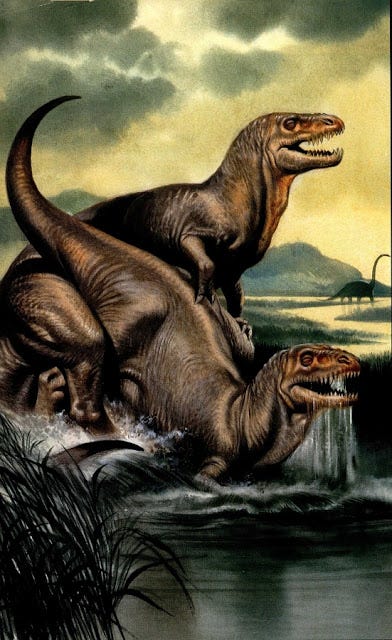
Sadly this is unlikely to make it into my book. Talking about dinosaurs in an art book about sci-fi is already a stretch, so I can’t take any rabbit trails here. See, this is why you follow my newsletter, to get the extra stuff my book won’t mention. Sign up for the paid version over here, cough cough.
***
All Hail The Science Fiction Encyclopedia, Bringer of Knowledge!
James Davis Nicoll, Tor.com
It was Peter Nicholls’ brainchild, but the work required a substantial team to turn the dream into a 672-page tome. Nicholls served as the general editor, with John Clute as associate editor, Carolyn Eardley as technical editor, and Malcolm Edwards and Brian Stableford as contributing editors. A team of ancillary experts provided further help. The encyclopedia held close to 3600 cross-referenced entries, covering authors, themes, and much more. The total word count? Some three quarters of a million words.
***
Interesting tweet of the day: The famous ‘Great Wave off Kanagawa’ woodblock print has a bigger impact on Westerners when flipped, because the original was made within a culture that read right to left, and therefore processed images the same way.
***
Favorite writing of the day: This scene from 1962’s Dr No. The aquarium was faked using stock footage of fish, but they didn’t have any impressive stock footage like sharks or something, so they just blew up footage of minnows and had the villian brag that the glass magnifies his fish in a “unique feat of engineering.”
The best part is that James Bond then says “Minnows pretending they are whales. Just like you on this island, Dr. No,” proving that there’s no cut-rate special effect that can’t be turned into a character-based bon mot.
***
Next Time on Retro Sci-Fi: A look at why Michael Whelan is so popular